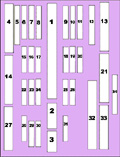






|

What is
a Mandala?
Mandala is a Sanskrit word
meaning "circle" or "round." In a religious context, it is a symmetrical
representation of the universe that can be sketched, painted, sculpted,
embroidered, drawn with sand, built as a temple or city, or represented
in motion through dance.
At right are examples of mandalas.
Click on the small image to see its larger version. |

|
Where did
they come from?
The word “mandala” originates in
Hindu and Buddhist practice, in which the mandala is a symbolic expression
of cosmology and serves as a teaching device for practitioners. The mandala
form originated in India and evolved in Tibet. Tibetan mandalas have four
(or multiples of four) sides. The outer corners are usually protectors
of the Buddha wisdom within. |

|
What are
they used for?
Carl Jung and other Western psychologists
have described the mandala as a universal expression of the human subconscious.
In general all mandalas have outer
and inner meanings. On the outer level, they represent the world in its
divine form; and on the inner level, they represent a map by which the
ordinary human mind is transformed into an enlightened mind.
Introduction
to the Gohonzon (The Great Mandala of the True Dharma)
When did
Nichiren first start inscribing the Gohonzon?
Nichiren Daishonin began inscribing
the Gohonzon after the Tatsunokuchi Persecution (see the picture at right).
He wrote about this incident in the
"Opening of the Eyes:" "On the twelfth day of the ninth month, this person
Nichiren was beheaded. It is his soul that has come to this island of Sado." |

|
In the "Misawa Gosho" (Letter to
Misawa), he wrote, "As for my teachings, regard those before my exile to
Sado as equivalent to the Buddha's pre-Lotus Sutra teachings." |

|
The Tatsunokuchi incident is regarded
as the time at which Nichiren Daishonin cast off his transient role as
the reincarnation of Bodhisattva Jogyo and revealed his true identity as
the original Buddha who appeared in the Latter Day of the Law.
What is the
purpose of the Gohonzon?
"Shakyamuni, Taho, and all the other
Buddhas in the ten directions represent the world of Buddhahood within
ourselves. By searching them out within us, we can receive the benefits
of Shakyamuni, Taho, and all other Buddhas."
—Major Writings,
Vol. 1, p. 64, "The True Object of Worship"
The image at right is a small image
of a Gohonzon diagram — in this case, it is a diagram of the Nichikan-transcribed
Gohonzon that is currently being issued by SGI.
Each numbered white rectangle corresponds
to a being on the Gohonzon. If you click the small diagram at right, you
will open up a much larger version of the diagram. Then, if you click on
the numbered white rectangles, you can see their names and brief descriptions.
Other explanations of those beings can be found throughout this site, i.e.,
"Top Row," "Special Characters" (use the navigation bars at left). |
 |

Images:
1. The top mandala was found using
Google Image Search. It was on a website that no longer exists.
2. The mandala of Shakyamuni Buddha
is from the Indonesian website http://www.tbsn.org/indonesian/shakyamuni.htm.
3. The picture of Nichiren at Tatsunokuchi
is the frontispiece of The Mikado's Empire by W.E. Griffis, published
1876 by Harper Bros.
4. "Nichiren on Sado Island" by Utagawa
Kuniyoshi, at the Museum für Ostasiatische Kunst - Berlin — scanned
from a holiday greeting card.
5. The Gohonzon Diagram is from the
SGI-USA
website.
Other Resources:
All Gosho quotes on this site are
from the Major Writings of Nichiren Daishonin. This material can
be accessed at the SGI-USA
Library.
Information on mandalas was gleaned
from many sources. Of particular help was a handout received at the Arthur
M. Sackler Gallery in Washington DC. The text was written by Robert E.
Fisher, E. J. Coleman, and Giuseppe Tucci.
|

![]()




